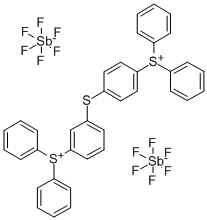Bis[4-(diphenylsulfonio)phenyl]sulfide bis(hexafluoroantimonate) CAS#: 89452-37-9; ChemWhat Code: 36565
Identification
Physical Data
| Appearance | White Powder |
Spectra
No data available
Route of Synthesis (ROS)
No data available
Safety and Hazards
| Pictogram(s) |   |
| Signal | Warning |
| GHS Hazard Statements | H302+H332 (56.5%): Harmful if swallowed or if inhaled [Warning Acute toxicity, oral; acute toxicity, inhalation] H302 (94.8%): Harmful if swallowed [Warning Acute toxicity, oral] H332 (94.8%): Harmful if inhaled [Warning Acute toxicity, inhalation] H411 (94.2%): Toxic to aquatic life with long lasting effects [Hazardous to the aquatic environment, long-term hazard] |
| Precautionary Statement Codes | P261, P264, P270, P271, P273, P301+P317, P304+P340, P317, P330, P391, and P501 (The corresponding statement to each P-code can be found at the GHS Classification page.) |
Source: European Chemicals Agency (ECHA)
License Note: Use of the information, documents and data from the ECHA website is subject to the terms and conditions of this Legal Notice, and subject to other binding limitations provided for under applicable law, the information, documents and data made available on the ECHA website may be reproduced, distributed and/or used, totally or in part, for non-commercial purposes provided that ECHA is acknowledged as the source: “Source: European Chemicals Agency, http://echa.europa.eu/”. Such acknowledgement must be included in each copy of the material. ECHA permits and encourages organisations and individuals to create links to the ECHA website under the following cumulative conditions: Links can only be made to webpages that provide a link to the Legal Notice page.
License URL: https://echa.europa.eu/web/guest/legal-notice
Record Name: (1-Cyano-2-ethoxy-2-oxoethylidenaminooxy)dimethylamino-morpholino-carbenium hexafluorophosphate
URL: https://echa.europa.eu/information-on-chemicals/cl-inventory-database/-/discli/details/213446
Description: The information provided here is aggregated from the “Notified classification and labelling” from ECHA’s C&L Inventory. Read more: https://echa.europa.eu/information-on-chemicals/cl-inventory-database
Other Data
No data available
| Use Pattern |
| Bis[4-(diphenylsulfonio)phenyl]sulfide bis(hexafluoroantimonate) is often associated with its role as a cationic photoinitiator. This class of compounds plays an important role in photocuring and polymerization reactions. The compound is often used in photocuring systems, such as polymerization reactions of epoxy resins and vinyl ether systems. It can generate cations under the irradiation of ultraviolet light or visible light to initiate the polymerization reaction of the resin. Compared with free radical initiators, cationic photoinitiators are still effective under conditions of lower oxygen content, which can overcome the problem that some free radical initiators have a decreased polymerization efficiency in air. High transparency and heat-resistant materials: Bis[4-(diphenylsulfonio)phenyl]sulfide bis(hexafluoroantimonate) can help manufacture high transparency photocurable materials, such as optical adhesives, electronic packaging materials, etc. Cationic polymerized materials tend to exhibit excellent heat resistance and mechanical properties, so this compound is suitable for applications in high temperature or high stress environments, such as electronic components and automotive coatings. |
Buy Reagent | |
| No reagent supplier? | Send quick inquiry to ChemWhat |
| Want to be listed here as a reagent supplier? (Paid service) | Click here to contact ChemWhat |
Approved Manufacturers | |
| Warshel Chemical Ltd | http://www.warshel.com/ |
| Want to be listed as an approved manufacturer (Requires approvement)? | Please download and fill out this form and send back to approved-manufacturers@chemwhat.com |
Other Suppliers | |
| Watson International Limited | Visit Watson Official Website |
Contact Us for Other Help | |
| Contact us for other information or services | Click here to contact ChemWhat |


